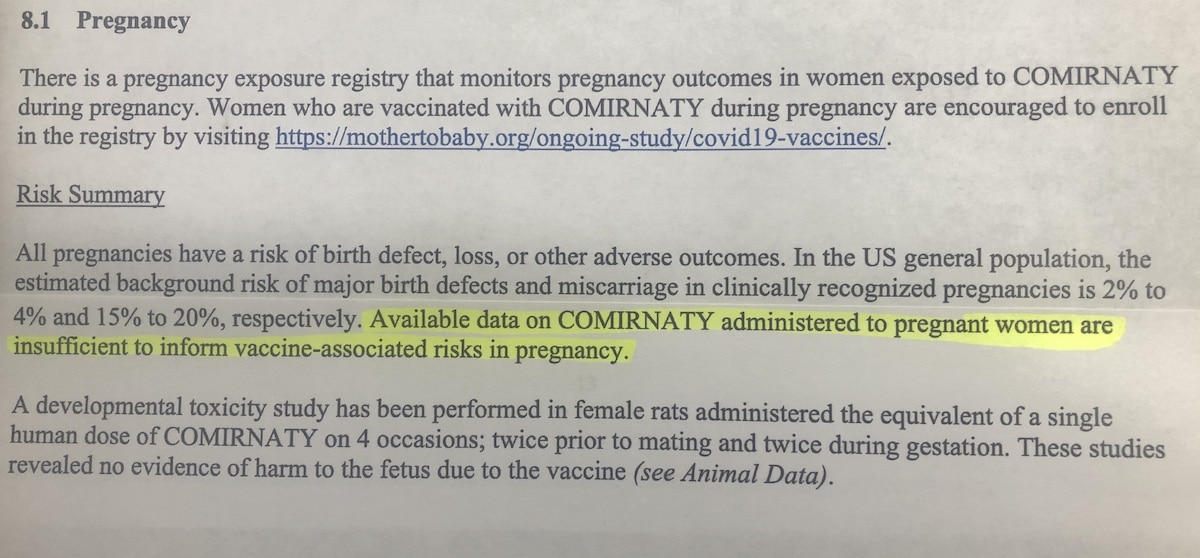
Fact-checkers screening for “misinformation,” please note: everything that follows are direct quotes from the FDA Authorization Letter for COMIRNATY, the FDA-approved COMIRNATY package insert, as well as direct quotes of Diana Bianchi, director of the National Institutes of Health Institute of Child Health and Human Development.
To clarify: The only approved vaccine is COMIRNATY. If this name is not on the vial of the vaccine one is being given, it’s not approved. This is important because vaccines provided under Emergency Use Authorization (EUA), including Pfizer’s non-COMIRNATY, Johnson & Johnson, and Moderna’s, have a liability shield.
The approval letter for COMIRNATY includes the following requirement for additional testing:
Effects on children under 16
Required Pediatric Studies:
Deferred pediatric Study C4591001 to evaluate the safety and effectiveness of COMIRNATY in children 12 years through 15 years of age.
Final Protocol Submission: October 7, 2020
Study Completion: May 31, 2023
Final Report Submission: October 31, 2023Deferred pediatric Study C4591007 to evaluate the safety and effectiveness of COMIRNATY in infants and children 6 months to <12 years of age.
Final Protocol Submission: February 8, 2021
Study Completion: November 30, 2023
Final Report Submission: May 31, 2024Deferred pediatric Study C4591023 to evaluate the safety and effectiveness of COMIRNATY in infants <6 months of age.
Final Protocol Submission: January 31, 2022
Study Completion: July 31, 2024
Final Report Submission: October 31, 2024
In other words, the safety for children will be determined over October 31, 2023 – October 31, 2024.
Risks of Myocarditis and pericarditis
Sweden and Denmark have recently banned the Moderna vaccine for those under age 30, following a rise in myocarditis and pericarditis. The FDA has expressed similar concerns of these risks from COMIRNATY, with lengthy sections in its authorization letter:
We have determined that an analysis of spontaneous postmarketing adverse events reported under section 505(k)(1) of the FDCA will not be sufficient to assess known serious risks of myocarditis and pericarditis and identify an unexpected serious risk of subclinical myocarditis.
The letter requires they conduct 6 different studies, with test results’ due dates spanning 2022 – 2027.
Risks to Pregnancies
Study C4591022, entitled “Pfizer-BioNTech COVID-19 Vaccine Exposure during Pregnancy: A Non-Interventional Post-Approval Safety Study of Pregnancy and Infant Outcomes in the Organization of Teratology Information Specialists (OTIS)/MotherToBaby Pregnancy Registry.”
Final Protocol Submission: July 1, 2021
Study Completion: June 30, 2025
Final Report Submission: December 31, 2025
COMIRNATY Package Insert: Vaccine-associated risks to pregnancy
8.1 Pregnancy
There is a pregnancy exposure registry that monitors pregnancy outcomes in women exposed to COMIRNATY during pregnancy. Women who are vaccinated with COMIRNATY during pregnancy are encouraged to enroll in the registry by visiting https://mothertobaby.org/ongoing-study/covid19-vaccines/.
Risk Summary
All pregnancies have a risk of birth defect, loss, or other adverse outcomes. In the US general population, the estimated background risk of major birth defects and miscarriage in clinically recognized pregnancies is 2% to 4% and 15% to 20%, respectively. Available data on COMIRNATY administered to pregnant women are insufficient to inform vaccine-associated risks in pregnancy. [Emphasis added]
A developmental toxicity study has been performed in female rats administered the equivalent of a single human dose of COMIRNATY on 4 occasions; twice prior to mating and twice during gestation. These studies revealed no evidence of harm to the fetus due to the vaccine (see Animal Data).
COMIRNATY Package Insert: Vaccine-associated risks to male fertility
13.1 Carcinogenesis, Mutagenesis, Impairment of Fertility
COMIRNATY has not been evaluated for the potential to cause carcinogenicity, genotoxicity, or impairment of male fertility. In a developmental toxicity study in rats with COMIRNATY there were no vaccine-related effects on female fertility [see Use in Specific Populations (8.1)].
And, following multiple reports from women of changes in menstrual cycles following vaccination, in announcing that NIH will now at last fund studies into the issue, Diana Biachi of the NIH acknowledged: “the [FDA] emergency use authorization was really focused on critical safety issues” and “changes to your menstrual cycle is really not a life and death issue.” (Some of us might be excused for thinking that a key indicator of the functioning of the female reproductive system is actually an issue of life.)
So, it all comes down to what bureaucrats decided constitute “critical safety issues,” if “full approval” can be granted long before studies into the risks outlined above are completed, and vaccine mandates can be issued for populations for whom its safety is as yet undetermined.
Let’s regain our perspective. The original intent of vaccines was to provide protection for vulnerable populations: the elderly, obese, and those with heart and lung problems. With a 99% survival rate, the Risk: Benefit calculation for others is considerably different, and a matter to be determined by individuals in consultation with their medical professionals.
Reprinted with permission from Independence Institute.

